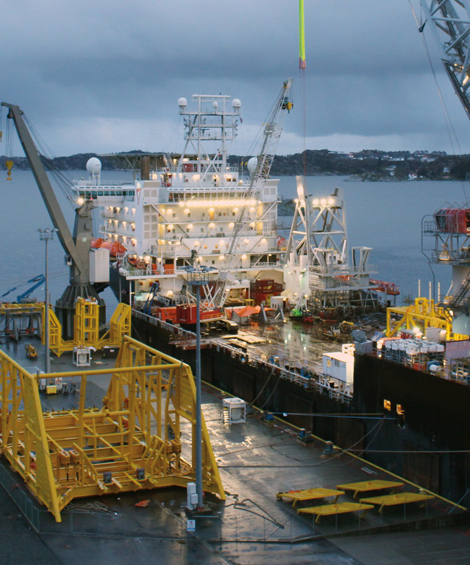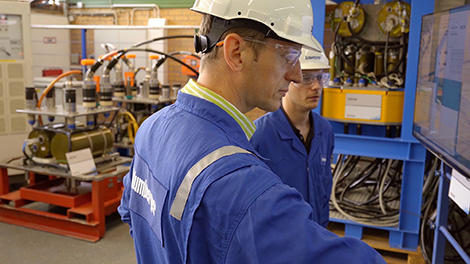
Components of a multiphase compressor for subsea processing applications are loaded onto a vessel in Horsøy, Norway, for delivery to an oil and gas field in the North Sea. OneSubsea Capital-Efficient Solutions deliver integrated subsea production systems that reduce project cycle time and overall cost.

OneSubsea Capital-Efficient Solutions (1:10)
One of the greatest challenges in deepwater oil and gas developments is controlling cost. Digital technology holds the promise of enabling domain experts to detect different ways to reduce cost when designing a subsea system from pore to process. One example could be a reduction in capital expenditure by redesigning the subsea architecture or the topside production system.
OneSubsea Capital-Efficient Solutions extend market-leading subsea boosting technology and are now an integral part of all customer projects. Capital-Efficient Solutions have reduced the average lead times of subsea products by more than 50%, saving up to 60% in project costs. As a portfolio of standardized designs that leverages streamlined engineering and manufacturing processes, OneSubsea delivers integrated subsea production systems that reduce project cycle time and overall cost.
At OneSubsea, early engagement with customers is essential to determine the best way to develop a field. Historically, this early engagement process can last from four to six months. During this time, OneSubsea and customer expert teams study the reservoir, looking closely at its expected flow dynamics, to answer specific questions. The new planning software that Schlumberger is currently developing and testing with customers will shorten the time it takes to obtain viable answers to all the questions that must be answered in the design of subsea development projects.
Our integrated teams of experts employ digital technology to explore multiple scenarios. To reduce the risks associated with complicated subsea developments, the teams need to explore as many scenarios as possible. However, the traditional approach to development entails collecting data from the customer that are used to iterate different concepts on paper for the field’s design. When this work takes place in a digital environment, multiple scenarios can be assessed in less time, which ultimately helps to decrease the time to first oil.
Having all the pertinent data from different domains in one integrated model also facilitates better collaboration between experts. As the integrated team of experts from the customer and OneSubsea moves forward with planning, it will also benefit from the cognitive abilities of this new subsea planning software.
Over time, monitoring services for subsea equipment have expanded to include production monitoring, such as real-time flow assurance consulting to optimize field production. Using software such as the PIPESIM* steady-state multiphase flow simulator and OLGA* dynamic multiphase flow simulator—both of which are available in the cloud-based DELFI cognitive E&P environment— in combination with production chemistry testing and customized advisory services, Schlumberger can provide a complete flow assurance solution for any type of oil and gas operational challenge. Furthermore, subsea monitoring uses all the data intelligence available from an operation to enable future intelligent design and manufacturing for new developments.

The three stations shown of the Manara production and reservoir management system control the production characteristics of an individual zone. Produced fluids, noted with green for oil and blue for water, flow through a screen to the station where pressure, temperature, flow rate, and water cut are measured.
Saudi Aramco had a vision and commitment to develop technology that would take hydrocarbon recovery to a new level. Named after the Arabic word for lighthouse, the Manara system is the result of an eight-year collaboration between Saudi Aramco and Schlumberger.
The Manara production and reservoir management system is an intelligent completion system for multizone, multilateral, extended-reach, and Extreme Reservoir Contact wells. Combining 30 patented technologies, the Manara system provides permanent downhole pressure, temperature, water cut, and flow rate monitoring as well as in-lateral flow control of zones in real time.
The information derived from a conventional completion system typically permits engineers to make production decisions in days or weeks. The Manara system’s real-time permanent monitoring reduces the decision-making time to hours. This means reservoir workflows that commonly required three to six months can now be performed in one day. Integrated workflows from multiple disciplines create a collaborative work environment, where the identification and correction of problems in individual zones are made in real time. Rig time is reduced by optimizing a zone-by-zone cleanup procedure that also minimizes health, safety, and environmental risks.
The Manara system uses fewer parts than a conventional completion system. Electric power and downhole data pass through an inductive coupler that can service any number of well junctions. One electric control line connects through the wellbore to the wellhead via a single penetration.
Saudi Aramco’s Dhahran Advanced Research Center coordinated user requirements and, in conjunction with Schlumberger Engineering, developed a qualification testing program to de-risk the enabling technologies in the Manara system. This included extensive field testing in multiple Saudi Aramco wells. The Schlumberger focus on the transformation themes of technology, reliability, efficiency, and integration was important for the successful collaboration with Saudi Aramco.